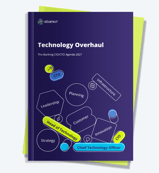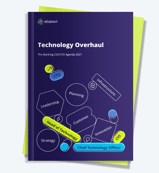This discussion panel highlighted the importance of trust, communication, and flexibility in partnerships between vendors and financial institutions, emphasizing shared goals, long-term collaboration, and balancing innovation with operational simplicity to build scalable, resilient ecosystems.
From vendor to partner: attributes of a thriving partnership
Recorded on June 12, 2025
![]()
![]()
![]()
![]()
![]()
SPEAKERS
SUMMARY
Key topics
Clear communication around goals, constraints, and success metrics are essential for a thriving partnership. Agreements are not fixed, but evolving.
Trust and flexibility allow both sides to navigate challenges together. Good partners understand constraints (budget, time, people) and adapt with you.
Events like this are opportunities to share challenges, spark ideas, and strengthen relationships to navigate future problems together.
Transcript
00:00:00 - Introduction
At the beginning of the panel discussion at the ebankIT summit, the moderator opened with a warm and enthusiastic tone, expressing how honored they felt to be part of what they deemed the most exciting panel of the event. Rather than formally introducing each speaker, the moderator invited the panelists to briefly present themselves, emphasizing the impressive level of banking experience present on stage.
The first speaker, Carlos Estrela, introduced himself as the Head of IT, CIO, and also acting CISO at CEMAH, a small bank located in the Azores, where he has worked for about 25 years. He noted the unusual situation of holding both CIO and CISO roles due to the bank’s size and explained that, although he is not officially an administrator, he contributes to the bank’s strategic direction.
Next, Joel Graham from Conexus Credit Union in Saskatchewan, Canada, spoke about his role in leading digital banking. He shared that Conexus is currently undergoing a merger process that could position them as the largest credit union in Saskatchewan and among the top in Canada. He emphasized his focus on digital applications and the ongoing transformation in their banking services.
Then, Robert Power took the floor, representing CGI and its services for the Canadian credit union sector. He explained that while CGI is a global company with 100,000 employees, his team of 300 focuses solely on supporting around 150 of the 200 Canadian credit unions. He acknowledged the dynamic changes happening in the space and was glad to be part of the discussion.
Another speaker, Luis Melo, reflected on his 24 years in banking, starting with ten years at Finibanco in Porto and continuing with 15 years at Banco Montepio, during which he gained 16 years of IT management experience. He shared that he recently stepped down from his position and is now exploring new career challenges.
The moderator then introduced the central theme of the discussion: exploring partnerships between financial institutions and service providers. They highlighted key values like trust and the human element in these collaborations, referencing conversations from the summit. With that, the moderator opened the floor for the panelists to discuss the foundational pillars that make such partnerships successful.
00:05:00 - The foundations of strong banking partnerships
Carlos Estrela opened the conversation on partnerships by emphasizing the importance of finding a provider who not only shares their vision of the market but also supports the bank’s unique goals—particularly around customer satisfaction. He compared a good partner to someone who helps you build your IKEA furniture rather than just watching from the couch, underlining the need for active collaboration rather than passive support. He highlighted ebankIT as a key long-term partner for his bank, essential to their ability to move forward.
Building on this, the moderator or next speaker brought up the idea of joint innovation, which led into a broader discussion about the pillars of partnership. One panelist outlined three pillars: viewing partnerships as relationships rather than contracts, assessing whether the engagement is short- or long-term, and evaluating whether the provider is truly helping to solve problems collaboratively. These ideas aligned closely with Carlos’s earlier comments and emphasized the growing digital ambitions of financial institutions, which require deep, strategic vendor support.
Robert Power expanded on the theme by suggesting that partnership is a competency modern organizations need to develop intentionally. He noted that today’s challenges are too complex for any single entity to solve alone, and those who can effectively build and manage ecosystems of partners—including vendors and customers—will unlock the most value. He illustrated the experience of feeling like a small fish in a big pond, stressing the need for providers who are willing to roll up their sleeves and journey alongside their clients.
Another panelist added that while innovation is essential in the financial industry, it often takes a back seat to daily operations and compliance burdens. This reality makes strong, risk-sharing partnerships even more vital. A good provider, they noted, must be willing to invest in a win-win relationship, sharing both risk and reward over the long term.
The discussion continued with reflections on the balance between cost and value. The panelists agreed that achieving this balance relies heavily on clear, ongoing communication. Just like in any healthy relationship, partners must frequently engage in honest conversations to align expectations, define boundaries, and ensure they’re moving in the same strategic direction.
00:10:00 - Building trust through transparency
Joel Graham responded to the ongoing discussion by reinforcing the idea that successful partnerships rely on basic relationship principles—clarity around shared vision, roles, and objectives. He stressed the need for shared metrics to track progress collaboratively and ensure both parties are aligned and moving toward the same goals.
From there, the conversation turned toward transparency, which all panelists agreed was a foundational element. One speaker emphasized that transparency determines how comfortable both sides feel in openly sharing their milestones, intentions, and challenges. Building trust also requires strong personal relationships across all organizational levels—from executives to working teams—enabling better communication and alignment.
The group acknowledged that partnerships demand investment: time, effort, and face-to-face interaction. One panelist noted how COVID-19 disrupted these in-person dynamics, creating a sense of distance, but now that travel and in-person engagement are returning, these relational aspects can be rebuilt to strengthen trust.
The discussion then shifted to the challenge of short-term business pressures. One speaker pointed out that companies involved in partnerships still need to meet revenue goals and may lack the time or resources to invest in long-term collaboration unless the value is clearly defined. This led to a call for evolving KPIs—to reflect not just short-term gains but also knowledge-sharing, innovation potential, and future readiness.
The idea of trust as a pillar was again reinforced. A panelist shared a personal practice of telling project managers that their counterpart on the client side should become their "new best friend", underlining the need for daily communication to build rapport and prevent misunderstandings.
Finally, the panel acknowledged that not all moments in a partnership are smooth. When challenges arise, open communication and honesty are essential. Frequent check-ins help set and reset expectations, minimizing the impact of difficult moments. As one participant summed up, dealing with conflict, system outages, and tough conversations is simply “part of the game” in professional collaboration.
00:15:00 - Scaling trust and managing complexity in partnerships
The discussion continued to emphasize the importance of early issue resolution in partnerships, with panelists agreeing that focusing on solutions rather than winning arguments is key. Carlos Estrela highlighted the mindset of “solving the problem, not the people,” and advocated treating setbacks like business cases—evaluating alternatives and choosing the most effective path forward.
They noted that trust and transparency are essential for overcoming inevitable issues, and strong relationships formed early on provide a foundation to resolve future challenges constructively. Robert Power humorously remarked that if everything seems to be going perfectly, something may be wrong—underscoring the need for continuous reflection and vigilance.
The conversation then shifted to multi-partner ecosystems in financial services. While traditionally banks would rely on a single vendor, today’s environment demands a more diversified approach. However, managing multiple fintech partners introduces complexity and operational risk. Panelists agreed that institutions must be strategic and selective, emphasizing dedicated oversight, long-term thinking, and treating each relationship as a product with its own lifecycle.
They warned against building oversized ecosystems solely for cost savings, as managing too many vendors without strong relationships can lead to inefficiency and overhead. Instead, the goal should be to scale partnerships through shared platforms and common rules, allowing for innovation while maintaining manageability. The panel concluded this segment by highlighting the balance between diversity of ideas and operational control in driving scalable innovation.
00:20:00 - Adapting partnerships to real-world constraints
The conversation focused on how the structure and success of partnerships often depend on the size of the organization and the flexibility of its systems. For example, banks using specific core systems may be tied to certain long-term partnerships. One participant shared a positive case study: a successful collaboration to launch Approva, a customer authentication app aimed at reducing phishing. Despite having limited initial requirements, the partnership thrived through trust, shared goals, and hands-on collaboration.
The discussion then shifted to aligning goals and expectations, especially during budget planning. Participants emphasized transparency, flexibility, and communication in negotiating project scopes and costs with partners. Instead of sticking rigidly to predefined plans, successful partnerships adapt, co-create solutions, and remain open to alternatives that still meet the intended goals—even if under financial constraints.
00:25:00 - Collaboration, trust & the value of real partnership
The discussion wrapped up by emphasizing partnerships as evolving, collaborative relationships built on mutual understanding, adaptability, and trust. True partners are seen not only as service providers but also as sources of valuable information and insight—comparable to close personal relationships. Flexibility, open dialogue, and co-investment in solving problems together, even under constraints, were highlighted as key factors in driving innovation and long-term success.
Speakers noted that great partnerships are two-way: vendors bring expertise from working with others, while clients contribute deep knowledge of their own business. When both sides take risks and collaborate transparently, the outcomes can be transformative.
Finally, they acknowledged the value of in-person events like the ebankIT conference for fostering those deeper relationships. These gatherings create space for idea-sharing, learning from others’ experiences, and reinforcing the kind of trust needed for resilient and productive partnerships.




%20without%20SAM%20-%20Maturity%20Level%20-%202-KO%20edit.webp?width=160&height=57&name=67768-ebankIT%20Platform%20-%20CMMI%20Development%20V2.0%20(CMMI-DEV)%20without%20SAM%20-%20Maturity%20Level%20-%202-KO%20edit.webp)
